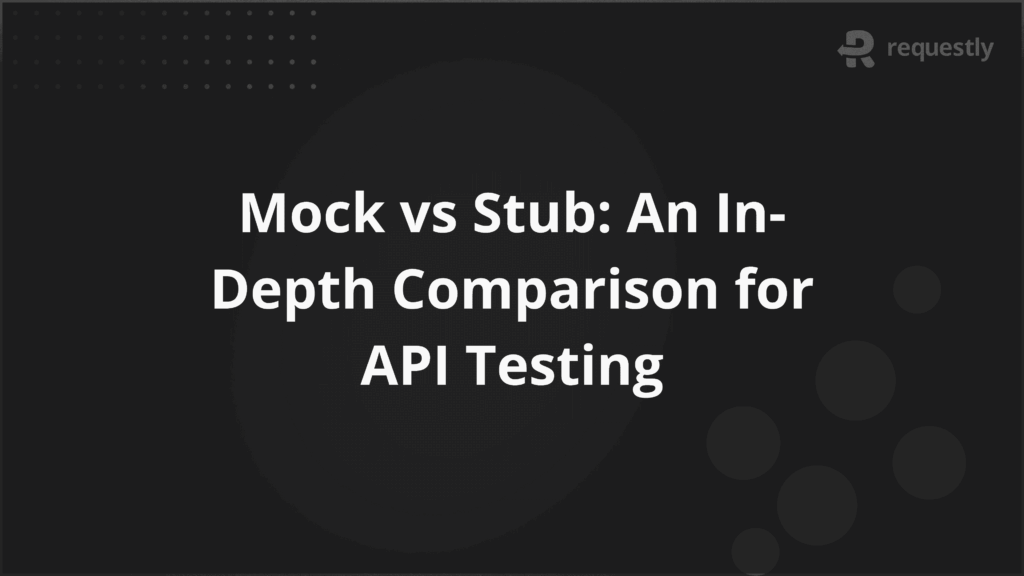Mock vs Stub: An In-Depth Comparison for API Testing


Testing APIs is not as simple as sending requests and checking responses. Development teams often have to deal with incomplete backend services, strict rate limits, delayed dependencies, or scenarios that are difficult, risky, or expensive to replicate using production APIs.
This is where API mocking and stubbing come in. Both strategies allow testers and developers to simulate API behavior without calling actual endpoints, but their intent and execution vary in meaningful ways.
This article explains the key differences between mocks and stubs so you can choose the right test double during API testing.
API Mocking: What It Means and When It’s Used
API mocking is the practice of simulating an API’s behavior by creating a fake version that returns predefined responses to specific requests. This allows developers and testers to mimic real-world API interactions, such as returning JSON data, status codes, or error messages without relying on the actual backend.
When should you use mocking?
- You’re testing how your code interacts with the API, not just how it handles the response.
- A specific method must be called with the correct parameters, and you want to verify that it happens.
- The outcome of your code depends on whether a call succeeds, fails, or is made in the right order.
- You need to simulate API behavior that changes based on the request like returning different data for different inputs.
- You’re modeling stateful flows where previous calls affect future responses.
Example:
If you’re building a banking app, you can mock the transactions API to simulate different scenarios like a successful deposit, an insufficient funds error during withdrawal, a fraud alert, or a temporary server outage. This lets you test how your app handles both expected and unexpected API responses before the real backend is available.
API Stubbing: Purpose and Role in Testing
API stubbing is the practice of creating lightweight, hardcoded responses for specific API calls. Unlike mocks, stubs don’t simulate full API behavior or track how your code uses them. Instead, they return fixed outputs for known inputs, allowing you to test your application’s internal logic without depending on real external systems.
When should you use stubbing?
- The API contract is clear, but you only need the simplest response to unblock development.
- You’re focused entirely on the consumer code’s behavior, without caring how it interacts with the external API.
- Tests should be fast, stable, and self-contained, with no delays, failures, or side effects from a live service.
- You’re not simulating business logic or state, just returning a known output for a known input.
- The range of responses is small and predictable. For example, always returning a 200 OK with a fixed payload.
- You’re not interested in whether the API was called correctly, only in how your code handles the response.
Example:
If your app calls a temperature API to display a reading on the dashboard, a stub might always return “25°C” for a fixed location like “Delhi”, allowing the UI to render and logic to run without depending on the real API.
Mock vs Stub: Key Differences You Should Know
Mocks and stubs play different roles in testing. Stubs return fixed outputs to help isolate logic, while mocks simulate behavior and verify how code interacts with dependencies. The table below highlights the key differences to help you decide which to use based on your testing goals.
| Aspect | Stub | Mock |
| Purpose | Return predefined outputs for known inputs | Simulate and verify API behavior and interactions |
| Behavior | Returns the same output for a specific input | Can vary output based on input, sequence, or internal state |
| Interaction Tracking | Does not track how it was called | Tracks call count, order, arguments, and can assert expectations |
| Verification Role | Used for state-based testing (does this output exist?) | Used for behavior-based testing (was this call made correctly?) |
| Failure Triggering | Cannot fail a test on its own | Can fail a test if expected calls don’t happen |
| Complexity | Simple to create manually | Often requires a mocking framework and setup |
| Test Fit | Good for unit tests where input/output is all that matters | Useful in integration/component tests that verify flow or coordination |
| Flexibility | Static and limited in scope | Dynamic, supports conditional behavior and chaining |
| Realism | Simulates a slice of an API | Mimics more realistic, context-aware API behavior |
| Use Case Example | Return a fixed product object in an e-commerce test | Ensure the cart service calls the payment API with correct parameters |
Choosing Between Mocks and Stubs
Mocks and stubs serve different testing needs. Use the list below to decide based on what you’re testing, how complex the interactions are, and what your test is meant to validate.
Consider using a mock when:
- Your code depends on how an external API behaves in response to specific inputs.
- Your component orchestrates multiple API calls and the sequence/order matters.
- Your test logic involves retry behavior, fallback logic, or circuit breakers triggered by mock failures.
- The API interaction is part of a larger flow (e.g., user registration>verification email>payment) and you want to confirm those steps happened.
- You’re working with event-driven systems and want to assert that a certain event or webhook was triggered.
Consider using a stub when:
- You want to simulate a consistent API response across many test cases without setting up complex conditions.
- The dependency is unreliable, rate-limited, or expensive to hit during development or CI runs.
- The API isn’t publicly accessible (e.g., dev-only endpoints or behind auth) and you want tests to run without real credentials.
- You’re testing edge cases or rare states that are hard to reproduce via the live system.
- You want to avoid adding third-party mocking libraries for simple test cases.
Strategies for Using Mocks and Stubs Effectively
Mocks and stubs often make tests harder to maintain when they introduce brittle assertions or tightly coupled logic. Here are a few strategies to use mocks and stubs effectively.
- Know what you’re testing: Use stubs when you want to control return values and test how your code reacts to specific data. Use mocks when the test outcome depends on how a dependency is used, such as call order, arguments passed, or number of invocations.
- Keep each test focused: Combining mocks and stubs in the same test often means you’re validating multiple things at once. This makes failures harder to trace and encourages unclear test boundaries. Separate them unless you’re specifically testing the interaction between behavior and data.
- Keep stubs simple: A stub should return a fixed output for a known input. If your stub includes conditions, branching logic, or side effects, it starts behaving like a partial implementation and reduces test clarity.
- Use mocks deliberately: Assert on method calls only when those interactions define the behavior under test. Avoid verifying calls that are internal implementation details, as this creates fragile tests that break during harmless refactors.
- Match the tool to the test type: Use stubs in unit tests to isolate core logic and avoid side effects. Use mocks in integration or component tests where coordination between modules matters. Don’t simulate behavior with stubs when you’re trying to validate communication patterns.
- Label and document your test doubles: Make the role of each test double explicit through naming and comments. For example, use names like emailServiceMock or authTokenStub and briefly note why the real dependency is not used.
How Requestly Helps With API Mocking and Stubbing
Requestly is a developer-friendly tool designed to intercept, modify, and simulate network traffic directly in the browser or on devices. It enables precise control over requests and responses during development and testing, making it well-suited for mocking and stubbing APIs in frontend, mobile, or integration workflows.
Here are the key features of Requestly that support API mocking and stubbing.
- Intercept HTTP requests and serve mock responses: Simulate unavailable endpoints, error conditions, or alternate data states by returning custom JSON or static payloads for matching requests.
- Stub specific endpoints with custom rules: Configure responses for targeted routes using specific status codes, headers, and bodies to test how your application handles predefined API behavior.
- Create conditional mocks based on request details: Set rules that match on method, URL, headers, query params, or request body to simulate varied responses based on different input conditions.
- Add latency or throttle API responses: Introduce delays to mimic slow networks, backend lag, or timeout scenarios and validate how your UI reacts under constrained conditions.
- Switch between mock sets for different scenarios: Organize rules into collections that represent success, failure, or empty states and toggle between them during development or testing.
- Share and manage mocks across your team: Save rule sets, sync configurations with team members, and maintain consistency across different machines or testing stages.
Conclusion
Mocks and stubs solve different problems. Use stubs when you’re controlling data to test logic in isolation. Use mocks when you’re verifying behavior, especially when it involves interaction between components or services.
Requestly fits cleanly into this process by giving you full control over both types of test doubles at the network level. Whether you’re stubbing API responses for deterministic unit tests or mocking service behavior to test flows across systems, Requestly lets you do it without rewriting application code.

Contents
Subscribe for latest updates
Share this article
Related posts






















